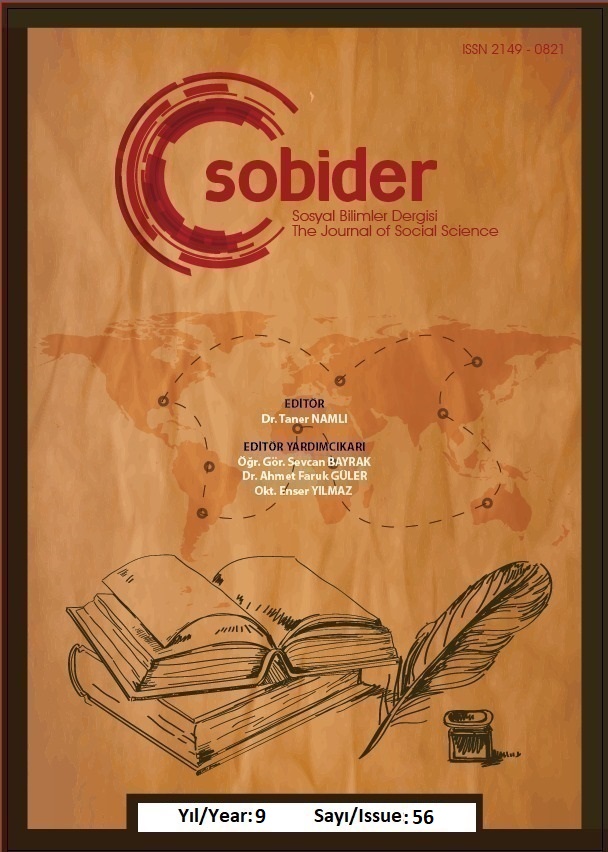ÖRGÜTSEL BOLLUK İLE FİRMA PERFORMANSI VE RİSK ARASINDAKİ İLİŞKİNİN İNCELENMESİ: PANEL ARDL YAKLAŞIMI
Author :
Abstract
Bu çalışmada, firmalar için önemli bir kaynak niteliğinde olan örgütsel bolluğun firma performansı ve firmaların risk alma dereceleri ile ilişkisinin belirlenmesi amaçlanmıştır. Bu doğrultuda, BİST Sürdürülebilirlik Endeksinde 2014-2020 yılları arasında sürekli olarak işlem gören dokuz firmanın yıllık frekanslı verileri panel veri analizi ile incelenmiştir. Araştırmanın değişkenleri örgütsel bolluğun türleri olan mevcut bolluk, iyileştirilebilir bolluk ve potansiyel bolluk ile risk ve performans ölçütleri olan finansal kaldıraç derecesi ve Tobin Q değerleri olarak belirlenmiştir. Analizlerde yatay kesit bağımlılığı, homojen/heterojenlik ve panel birim kök testlerinden sonra eşbütünleşme testleri uygulanmıştır. Değişkenler arasındaki eşbütünleşme ilişkisinin varlığından dolayı heterojen panellerin katsayı tahmini için Panel ARDL-CCEMG yöntemi tercih edilmiştir. Ulaşılan sonuçlara göre mevcut bolluğun hem firma performansı (0.138) hem de risk alma derecesi (38.439) ile pozitif bir ilişkisi olduğu belirlenmiştir. Ayrıca iyileştirilebilir bolluğun, performans (-0.510) ile negatif, risk seviyesi (47.589) ile pozitif bir ilişkisi bulunmuşken, potansiyel bolluğun her iki değişken için de (p>0.05) önemli olmadığı tespit edilmiştir.
Keywords
Abstract
In this study, it is aimed to determine the relationship between organizational slack, which is an important resource for firms, with firm performance and risk-taking degrees of firms. In this direction, the annual frequency data of nine companies that were continuously traded in the BIST Sustainability Index between 2014-2020 were analyzed by panel data analysis. The variables of the research were determined as the types of organizational slack, which are available slack, recoverable slack and potential slack, and financial leverage and Tobin Q values, which are risk and performance criteria. After determining the cross-sectional dependence in the analyzes, it was found that the slope coefficients in the model were heterogeneous. Cointegration tests were applied after appropriate panel unit root tests to check the stationarity of the series. Due to the existence of the cointegration relationship between the variables, the coefficients of the heterogeneous panels were estimated with the CCEMG estimator developed by Pesaran (2006). According to the results, it has been determined that the available slack has a positive relationship with both firm performance (0.138) and the degree of risk taking (38.439). In addition, recoverable slack was negatively correlated with performance (-0.510) and positively correlated with risk level (47.589), while potential slack was not significant for both variables (p>0.05).
Keywords
- Alessandri, T., Cerrato, D. ve Depperu, D. (2014) ‘‘Organizational Slack, Experience, and Acquisition Behavior Across Varying Economic Environments’’, Management Decision, 52 (5): 967-982.
- Bourgeois, L. (1981) ‘‘On the Measurement of Organizational Slack’’, Academy of Management Review, 6 (1): 29-39
- Bromiley, P. (1991) ‘‘Testing A Causal Model of Corporate Risk Taking and Performance’’, Academy of Management Journal, 34 (1): 37-59.
- Chiu, Y.C. ve Liaw, Y.C. (2009) ‘‘Organizational Slack: is More or Less Better?’’, Journal of Organizational Change Management, 22(3): 321-342.
- Cyert, R. ve March, J. (1963) ‘‘A behavioral Theory of The Firm’’, Upper Saddle River, New Jersey: Prentice-Hall/Pearson Education.
- Daniel, F., Franz T. L., Charles J. F. ve R. Andrew T. (2004) “Slack Resources and Firm Performance: A Meta-Analysis,” Journal of Business Research, 57(6): 565-574.
- Donada, C. ve Dostaler, I. (2005) ‘‘Relational Antecedents of Organizational Slack: An Empirical Study into Supplier-Customer Relationships’’, M@n@gement, 8: 25-46.
- Fox, C. (2014) ‘‘Organizational Slack and Managerial Attention to Risk: Impact on an Organization's Experience with Harmful Surprises’’, Doctor of philosophy. Oklahoma State University.
- Gürkan, N. (2016) ‘‘Örgütlerde Kaynak Bilgisi ve Örgütsel Bolluğun Girişimsel Oryantasyon Üzerindeki Etkisi’’, Doktora Tezi, Bülent Ecevit Üniversitesi, Sosyal Bilimler Enstitüsü, Zonguldak.
- March J ve Simon H. (1958) ‘‘Organizations’’, NewYork: Wiley.
- Moses, O.D. (1992) ‘‘Organizational Slack and Risktaking Behaviour: Tests of Product Pricing Strategy’’, Journal of Organizational Change Management, 5(3): 38-54.
- Nohria, N. ve Gulati, R. (1996) “Is Slack Good or Bad For Innovation”, Academy of Management Journal, 39(5): 1245-64.
- Peng, M. W., Li Y., Xie E. ve Su Z. (2010) “CEO Duality, Organizational Slack, and Firm Performance in China,”, Asia Pacific Journal of Management, 27(4): 611-624.
- Sharfman, M. P., Wolf, G., Chase, R. B. ve Tansık, D. A. (1988) ‘‘Antecedents of Organizational Slack’’, The Academy of Management Review , 13(14): 601-14.
- Singh, J. V. (1986) “Performance, Slack, and Risk Taking in Organizational Decision Making,” Academy of Management Journal, 29: 562-585.
- Su, Z., Xie, E. ve Li, Y. (2009) “Organizational Slack and Firm Performance during Institutional Transitions’’, Asia Pac J Manag, 26(1):75–91.
- Tan, J. (2003) “Curvilinear Relationship Between Organizational Slack and Firm Performance:: Evidence from Chinese State Enterprises’’, European Management Journal 21(6):740749.
- Tan, J.ve Peng, M.W. (2003) “Organizational Slack And Firm Performance During Economic Transitions: Two Studies From An Emerging Economy’’, Strategic Management Journal, 24(13):1249–1263.
- Borsa İstanbul, https://www.borsaistanbul.com/tr/sayfa/165/bist-surdurulebilirlik-endeksi (15.12.2021)





